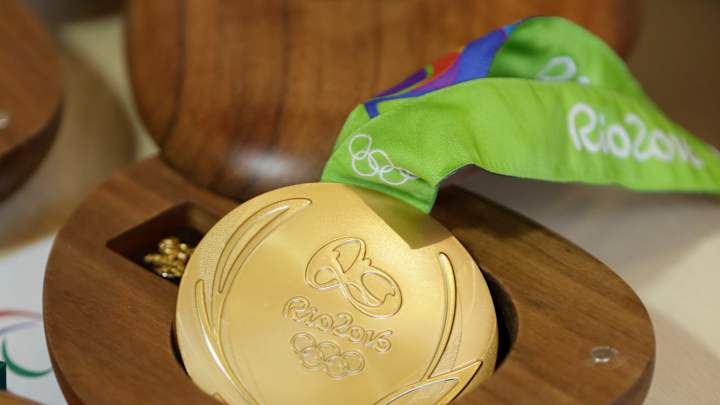Gold medals in Rio are barely gold at all. Here's why.

Gold medals are the ultimate prize in Olympic sport.
They're also a misnomer.
There's no such thing as a ''gold'' medal, not at these upcoming Rio Olympics - and really, not ever. Second-place finishers get silver medals and oddly enough, so do the winners, albeit theirs are plated in a tiny amount of gold.
That factoid caught even some of those who were put in charge of making the 5,000 or so medals needed for these Rio Games by surprise.
''Our operators and some of our developers had the same question,'' said Victor Hugo Berbert, who managed the medal-making process and was part of a team of about 100 people at the Brazilian Mint who were part of the project. ''We can produce medals out of pure gold. But we know how expensive they are. So gold medals ... are not exactly pure gold.''
They're barely gold at all.
The medals given to champions at these Olympics will weigh just over a pound, so to make them entirely from gold would have cost about $23,500 in material, each. By taking the silver medals and then plating them in a tiny amount of Brazilian gold, the actual value of the metal inside those metals is about $600.
Not that the athletes will mind.
''The gold medal,'' hockey legend Wayne Gretzky famously said at the Salt Lake Olympics in 2002 when he was executive director of the gold-winning Canadian team, ''is everything.''
Though there are a number of exceptions, it's not uncommon for the medal-making process to fall to the host country's national mint. That was the case this year, with Berbert saying it took about two years for the entire process to play itself out - starting with discussions on design with the host organizing committee, sketches, ideas, budgeting and ultimately approval from the International Olympic Committee.
The medals for the Olympics are done. Work is ongoing on the medals for the Paralympics, which follow in Brazil later this summer.
''We needed to develop the whole concept of the medal. We worked a lot with the committee about the art, about the design, about the materials,'' Berbert said. ''We tried to catch what they wanted to show in a Olympic medal and we took our experience, our know-how in producing medals and turn that into what they want. The art came from the committee, but our team needed to sculpt them.''
The gold is certified to have a certain amount of purity and is considered very high quality. The silver and ''bronze'' medals (and by the way, they're not really bronze) are largely made from recycled materials, which is a source of pride for the team that Berbert represents. Sustainability, he said, was an important goal for the team.
The silver for both the first- and second-place medals was culled in part from mirrors and plates. The bronze medals are made in part from the same copper that goes into Brazilian coin, so the mint had plenty of that to use in the Olympic project. About 40 percent of what was needed was already on hand when the process started.
Even some of the plastic used in the ribbons that will be attached to the medals is recycled.
''It's something we dreamed of,'' Berbert said. ''When they called us, we adored the project. We really wanted to do this thing.''
The other obvious advantage of using the mint to make the medals is security. And every precaution is being taken to ensure that nothing goes wrong now.
The mint will store the medals and basically deliver them to the organizing committee on a day-to-day basis - the medals that will be awarded on a given day will be kept safe as can be until needed.
''We have special dates with the committee where they want them delivered,'' Berbert said. ''There are logistics on how to transfer them to them ... until then, we keep the medals in a safe room. But all the Olympic medals are packaged now, identified by the event and competition, all organized and ready to be delivered.''
Ready to be won, too.
